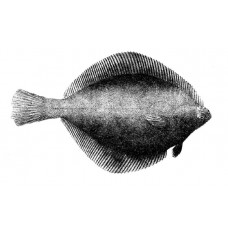Latin name
Limanda limanda
Other name
Limanda limanda
Identification
A distinctive feature of the common dab is the lateral line with a curve above the pectoral fin. The eyes are located on the right side of the body and are separated by a narrow bony ridge. The mouth is small. The body is covered with fine superficial scales. The pyloric appendages are long. There are 6 or more teeth on each jaw on the ocular side of the head. The teeth on the jaws are conical, single-rowed, with no single cutting edge. There is no distinct rough ridge behind the eyes. Gill stamens short and thick.
Features of fish fins
The pelvic fins of these fish are symmetrical with a narrow base. The caudal fin has 11-12 rays.
Fish colouring
The coloration of the ocular side is sandy brown with darker spots. The underside of the body is white.
Distribution
This species is widespread in the seas along the western and northern coasts of Europe from the Bay of Biscay to the White Sea. In Russia, it inhabits the Gulf of Finland, the Barents Sea and the White Sea, especially the Onega and Kandalaksha bays. Its range extends westward to Iceland.
Habitat
Bottom fish inhabiting the coastal zone not deeper than 50-70 meters.
Size
The average length of fish of this species is 20-30 cm, sometimes up to 40 cm. Maximum recorded body weight is 1 kg, usually 150-300 grams. Maximum recorded age: 12 years.
Behavior
Common dabs do not migrate.
Food and feeding habits
The diet of these fish is based on various invertebrates such as worms, ophiura, small crustaceans, mollusks. Smaller fish are less common.
Reproduction
During the spawning season from January to August, the common dab moves closer to the shore to a depth of 25-50 meters. Fecundity is 80-140 thousand eggs, 0.7-1 mm in diameter. Symmetrical larvae emerge from the eggs, settle at a depth of 10-20 meters and switch to a bottom lifestyle before acquiring an asymmetrical body shape.
Fishing
It is a commercial fish. There are no large commercial catches. It is sometimes caught as bycatch when fishing for other species. At sea, it is caught by trawling, but it can also be caught from the shore.
Relationship with a person
Harmless. It is an inexpensive fish. It is sold fresh, frozen, dried or smoked at fish markets.
| Classification | |
| Phylum | Chordata |
| Class | Actinopterygii |
| Squad | Carangiformes |
| Family | Pleuronectidae |
| Genus | Limanda |
| Species | L. limanda |
| Features | |
| Conservation status | Least Concern |
| Habitat | Bottom |
| Life span, years | 12 |
| Maximum body weight, kg | 1 |
| Maximum length, cm | 40 |
| Sailing speed, m/s | No information |
| Threat to people | Edible |
| Way of eating | Planktonophage |
Common dab
Tags: common dab

